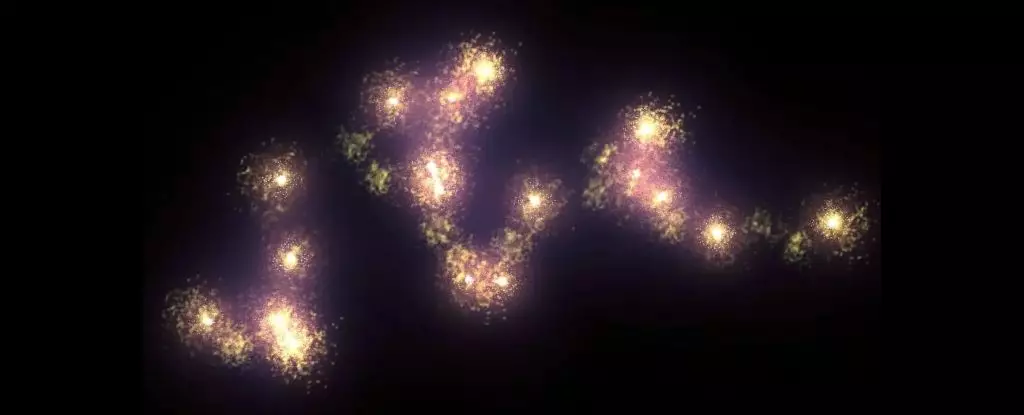For decades, astrophysicists have endeavored to piece together the cosmos, unveiling its myriad mysteries. Among these, the Hercules-Corona Borealis Great Wall has captured attention as a colossal network of galaxies that was previously measured to span about 10 billion light-years. However, groundbreaking research hints that our understanding of this structure is about to undergo a seismic shift, as new calculations suggest that it could be a staggering 15 billion light-years long. This re-evaluation challenges not only our knowledge of astrophysics but also poses significant ramifications for our comprehension of the universe’s structure and evolution.
The Universe has long been a region of intrigue, with astronomers frequently pushing the boundaries of our understanding. The study in question, which meticulously analyzes the distribution of gamma-ray bursts—one of the most vigorous explosions known—suggests that what we thought we knew about the vastness of the Universe might only represent the tip of an astronomical iceberg. The implications of this research echo throughout the scientific community, inviting further examination of the gravitational forces that shape the cosmos.
Gamma-ray Bursts: Celestial Beacons of Galactic Formation
Gamma-ray bursts (GRBs), the universe’s flashiest fireworks, are powerful events associated with high-energy explosions such as core-collapse supernovae or neutron star collisions. Their bright emissions allow astronomers to spot these cataclysmic occurrences across massive cosmic distances, providing us with a method to map the intricacies of galaxy clusters. In 2014, a trio of researchers—István Horváth, Jon Hakkila, and Zsolt Bagoly—first identified the Great Wall by studying gamma-ray bursts and noticing an anomalously high concentration in specific regions of space.
Their recent efforts, now involving a wider team and a more extensive dataset of 542 gamma-ray bursts and their redshifts, paint a clearer picture of the Great Wall’s true dimensions. The measurement of redshift effectively stretches the perceived colors of the bursts due to the expanding universe, enabling scientists to deduce distances with greater accuracy. The newfound breadth of this structure poses critical questions about the formation and distribution of galaxies within our universe.
The Paradigm Shift in Cosmology
The findings that the Great Wall may be an immense 15 billion light-years long not only raises eyebrows, but also contradicts the fundamentals of the cosmological principle. This principle suggests that, on a large scale, matter is distributed uniformly throughout the universe. Any structure surpassing about 1.2 billion light-years would challenge this notion, and yet multiple structures, including the Great Wall, seem to defy this cosmic ‘smoothness.’
To grasp the significance of these findings, we must delve into the ramifications for cosmology. Key structures identified—like the Quipu and the Sloan Great Wall—provide evidence for large-scale cosmic formations; however, the updated dimensions of the Great Wall push these limits even further. With a critical tally of similar structures revealing the existence of enormous collections of galaxies, we must confront the reality that our universe is far from the homogeneous expanse we once believed it to be.
A New Frontier in Cosmic Discovery
As scientists probe deeper into the characteristics of the Hercules-Corona Borealis Great Wall, it becomes abundantly clear that the Universe may have hidden complexities that remain uncharted. The very existence of such a massive structure prompts questions about how galaxies interact, evolve, and arrange themselves within the cosmic tapestry. Are gravitational forces at play that manifest localized concentrations of galaxies? How do these structures form and what roles do they play in the broader universe?
This critical juncture in astrophysics not only emphasizes our ignorance in the vastness of the cosmos but also inspires curiosity to reveal the secrets that lie ahead. As discoveries unfold, they challenge existing paradigms and encourage scientists to refine their theories regarding cosmological evolution and the processes governing galaxy formation.
The universe, as we learn more about its intricacies, beckons with new mysteries to solve. The exploration of such monumental structures as the Hercules-Corona Borealis Great Wall illuminates an ever-evolving quest for understanding. With every revelation, we inch closer to grasping the universe’s true size and nature, continuously igniting the passion for discovery and knowledge within the scientific community. The adventure is just beginning.


Leave a Reply